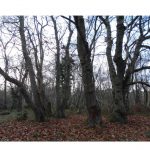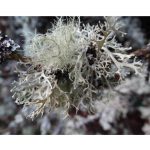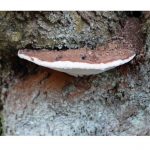Roger Dobbs led a walk at BBOWT’s Bowdown Woods reserve, which lies to the north of Greenham Common, on the clear, cold afternoon of Sunday 26 November. Members gathered at the Bomb Site car park before heading out to an enormous old Sweet Chestnut stool in the woods on the northern side of the Bomb Site. Originally a single specimen, it is now a ring of 5 big multi-stemmed trees. Nearby was a big clump of Scaly Male Fern. The route then led into the open area at the centre of the Bomb Site. It had originally been open heathland, but had become covered with dense Oak and Silver Birch. Many of the trees have now been cleared, leaving an open area of grass, heather and scrub. Highland cattle, Dexter cows and ponies have all been tried for keeping the scrub down, but none had proved satisfactory – they just ate the grass and avoided the scrub. So now the area is either mown or brush-cut to control the vegetation. The walk continued into the former Baynes Reserve, emerging at the top of a ridge overlooking a long valley with a clearing below power lines. The steep south-facing slope below the ridge is regularly cleared, making ideal sunny butterfly habitat. The path dropped steeply down to the valley bottom, where a Southern Bracket Ganoderma australe was found on an Alder stump. On the far side of the valley were tall multi-stemmed Alders. Roger explained that the grass in the valley bottom is cut each year on alternate sides. While he was talking, a vole was spotted, running through the grass. Continuing down the valley, the woodland on the northern slope is being actively managed for Dormice. Hazel in the first section was coppiced a few years ago and is growing back strongly. The second section has big old Hazels which have not been cut. Several had nestboxes attached between 1 and 2 metres above the ground, with the entrance hole at the back against the tree trunk. In total, about 70 Dormouse boxes have been put up across the reserve. The third section was very wet, and had sparse recently coppiced Hazel. The fourth section has not been cut yet. The walk continued to the small stream, cut deep into a meandering course. Both Beautiful and Banded Demoiselles and Golden-ringed Dragonflies are regularly seen in the valley. A Raven flew calling overhead. The route then led back up the steep valley side, where a wide south-facing ride had recently been cleared. Leaves of Sanicle, Wood Spurge and Yellow Archangel were all seen in this part of the woods. Towards the top of the hill was a flat grassy terrace with a pond where Smooth, Palmate and Great Crested Newts can all be found. In summer, Common Spotted-orchids are abundant here and solitary bees use the exposed sandy bank at the back of the terrace. The path led back up to the main track round the Bomb Site. The low wall and containing banks of the area where bombs used to be stored can still be seen. The track led to an open area where Grayling butterflies have sometimes been seen and a row of oaks where Purple Hairstreaks are regularly found. The light was beginning to fade when the group returned to the car park.
Pictures by Laurie Haseler



